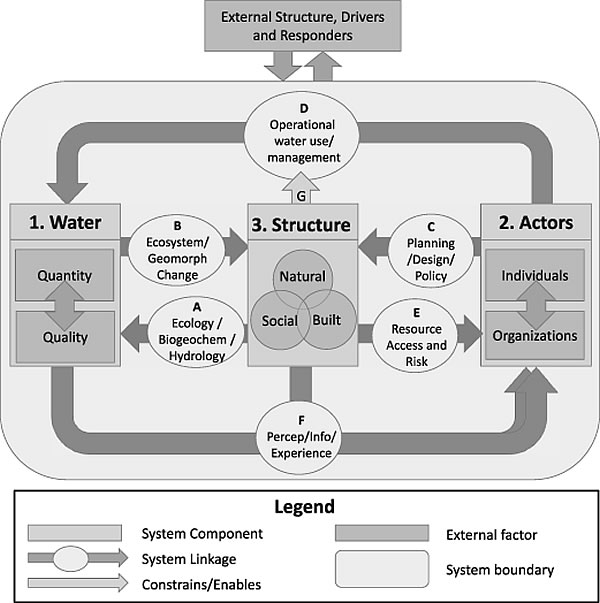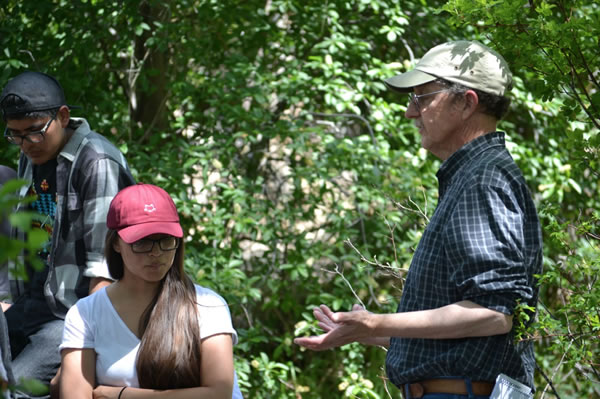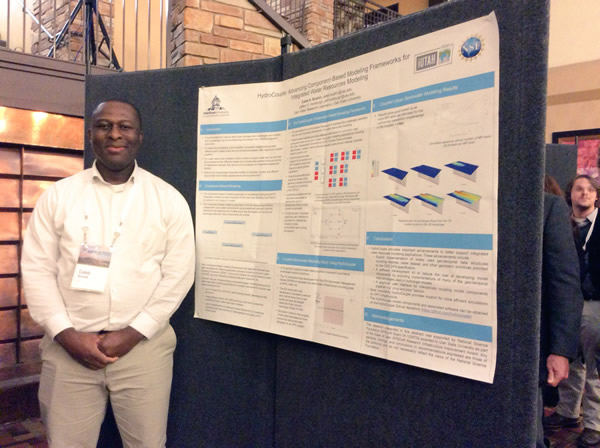News and Highlights
This is a list of past iUTAH EPSCoR news from 2012 to 2018.
February 23, 2018
Homeowner Preferences Drive Tree Diversity in Salt Lake Valley
iUTAH researchers Diane Pataki from University of Utah and Joanna Endter-Wada from Utah State University have been in the news for their research on tree diversity in Salt Lake Valley.
A media release provided by the University of Utah’s science writer Paul Gabrielsen said “Utah’s early residents would be surprised to see the canopy of trees that covers the Salt Lake Valley today. Few trees are native to the valley, which means that most of the trees present there today are imported. It’s a much different situation from a natural forest, which is shaped by climate, water availability and biodiversity.
The article goes on to add that “tree species diversity can be shaped by the species available in nurseries, the preferences of the homeowners, and even the tree selections of their neighbors. ‘Ecology started out as a descriptive discipline,’ Pataki says. ‘You want to understand why you see the distribution of species that you do. This paper states what is out there in Salt Lake, and makes the best attempt we can to figure out why.’
Urban ecology incorporates social science into ecology and is a relatively unexplored field. So, Pataki and Avolio didn’t have much precedent to go on when designing their study. They began by looking at comparable neighborhoods in the Salt Lake Valley and chose nine neighborhoods representing combinations of median home age (pre-1939, 1951-1970 and 1985-2005) and median household income (less than $45K, $45-85K and more than $85K). From those neighborhoods, they chose five or six blocks to survey, and sent postcard surveys to homeowners, followed up with in-person visits in 2014. The researchers were looking at the tree species present both in homeowner’s yards and in streets. In the homeowner surveys, researchers asked what people liked about the trees in their yard, and what factors led them to remove trees."
Findings also show “that yards and neighborhoods close to each other had more similar species patterns, suggesting that neighborhoods have distinctive landscape identities. ‘These landscape identities likely contribute to the role that trees have in creating a sense of place,’ the team writes, ‘whereby people form a bond with specific trees and with the attributes of a place that trees help create.’ Pataki adds: ‘When you walk through a forest, you see different environments. That’s probably driven by soil characteristics or slope. Maybe in neighborhoods, people influence each other’s plant preferences.’”
Former U postdoctoral scholar Meghan Avolio, now a professor at Johns Hopkins University, and Tara L.E. Trammell from the University of Delaware were also co-authors of this study. The National-Socio Environmental Synthesis Center (SESYNC) supported this research. While not an iUTAH-funded activity, the study relates to urban sustainability in Utah.
Press: Science Daily | UNews

January 31, 2018
Dust on Snow Controls Springtime River Rise in West

University of Utah and iUTAH researcher McKenzie Skiles has been in the news for her contribution to research on the effects of dust on mountain snowpack during spring runoff. Skiles received funding through an iUTAH Research Catalyst grant on snow hydrology along the Wasatch Front in 2017.
A media release provided by the University of Utah’s science writer Lisa Potter said the “study has found that dust, not spring warmth, controls the pace of spring snowmelt that feeds the headwaters of the Colorado River. Contrary to conventional wisdom, the amount of dust on the mountain snowpack controls how fast the Colorado Basin’s rivers rise in the spring regardless of air temperature, with more dust correlated with faster spring runoff and higher peak flows.
The finding is valuable for western water managers and advances our understanding of how freshwater resources, in the form of snow and ice, will respond to warming temperatures in the future. By improving knowledge of what controls the melting of snow, it improves understanding of the controls on how much solar heat Earth reflects back into space and how much it absorbs — an important factor in studies of weather and climate.
Coauthor McKenzie Skiles, an assistant professor in the University of Utah Department of Geography, said that while the impacts of dust in the air, such as reduced air quality, are well known, the impacts of the dust once it’s been deposited on the land surface are not as well understood. ‘Given the reliance of the western U.S. on the natural snow reservoir, and the Colorado River in particular, it is critical to evaluate the impact of increasing dust deposition on the mountain snowpack,’ she said.”
The article titled “Variation in rising limb of Colorado River snowmelt runoff hydrograph controlled by dust radiative forcing in snow” was published in the journal Geophysical Research Letters. Along with Tom Painter of NASA’s Jet Propulsion Laboratory in Pasadena, California and McKenzie Skiles from the University of Utah, Salt Lake City, other coauthors are from University of Colorado, Boulder; and University of California, Santa Barbara.
Press: Jet Propulsion Laboratory website | UNews
January 31, 2018
Social Position Influences Water Perception Gap
A new study has found that city leader's views may not be aligned with the public they serve on key water issues. Melissa Haeffner, former iUTAH post-doctoral researcher, and colleagues looked at how socio-hydrology models may oversimplify results by suggesting that social structure are equally and fully informed of the issues or would respond to cues in the same way.
Researchers were able to compare concerns about the current and future water supply, water shortages, quality, cost, and infrastructure through the use of surveys and interviews with urban Utah Mayors, City Council persons, public utilities staff, and residents. More information on surveys can be found at Utah's Water Future - 2014 Household Survey and the Utah Water Survey found on the HydroShare data repository.
Results of the surveys suggest that residents were more concerned about future water shortages and high water costs while leaders were more concerned with deteriorating water infrastructure. This view remained consistent independent of where cities were located or what water source they used. It was found that leaders thought that their relationship with their residents was largely reactive.
The finding is valuable in demonstrating how misaligned expectations between leaders and constituents may result in unintended consequences. It suggests that a greater attention to the values, norms, and attitudes held by each group of people with different roles serves both policymakers as well as researchers developing socio-hydrological models.
This study has many connections to iUTAH project research, including the model introduced by researchers in the published study “iSAW: Integrating Structure, Actors, and Water to Study Socio-Hydro-Ecological Systems,” which appeared in the journal Earth’s Future in March 2015. The iSAW model is an integrated framework for human-water system sustainability and has been used in this new study.
Authors of the article include Melissa Haeffner, Douglas Jackson-Smith, and Courtney G. Flint. While the article will be released later in 2018 under the title “Social Position Influencing the Water Perception Gap Between Local Leaders and Constituents in a Socio-Hydrological System,” it is available ahead of publication through the journal Water Resources Research.

December 4, 2017
Researcher and Team Contribute to Restoration Efforts
iUTAH Education, Outreach and Diversity Director Mark Brunson, professor in the Department of Environment & Society at Utah State University, is contributing to restoration efforts by the Shoshone Nation on the site of the Bear River Massacre near Preston ID.
An excerpt from the Herald Journal writer Sean Dolan said “When Darren Parry was a child, his grandmother took him to the site of the Bear River Massacre. He didn’t quite understand why she always had a tear in her eye she when pointed out where the lodges used to be. As he has grown older and taken on leadership roles in the Northwestern Band of The Shoshone Nation, he now understands how important it is to honor a request she made before passing away five years ago.
Brunson and his team, "after consulting with Parry, [will be} preparing a description of what that restoration might look like. One of the main challenges will be removing the invasive Russian olive trees, which Utah classifies as noxious weeds. Then, Parry and Brunson hope to plant native grasses, shrubs and trees. Part of the process is gathering information on what the land used to look like and what plants are indigenous to that area.
"During his research, Brunson said he came across a map drawn by a soldier led by Col. Patrick Connor that included several willow thickets around the Bear River. Willows are no longer found in that area, which Brunson said could be due to the river shifting and cattle grazing. Parry said willows were vital to the Shoshone people. ‘They used the willows as protection from the weather, and they made things out of it,’ he said. The willows were just one aspect that made that valley an ideal winter camp. Parry said the largest natural spring in the county is nearby, and there are several natural hot springs around the river.”
Brunson said that a team, including Molly Cannon, director of the Museum of Anthropology, Eugene Schupp, professor in the Department of Wildland Resources, and Matt Munson, an undergrad researcher, all from USU, are conducting assessments and preparing a proposal to develop a restoration plan.

November 28, 2017
In the Balance: Communication Flow
iUTAH and Utah State University researchers Bethany Neilson, an associate professor in Civil and Environmental Engineering Departments, and graduate student Julie Kelso were included in USU’s Winter 2017 alumni magazine. The article “In the Balance” features Neilson, Kelso, and other scientists, each grappling with how to adjust and mitigate water solutions for the future.
An excerpt from the story by John DeVilbiss tells of Julie’s journey from water researcher to water communicator this way. “After years of monitoring water quality on the rivers of Logan, Provo, Red Butte, and Jordan, Kelso says she now finds herself trying to communicate it to others in a meaningful way. It has been both eye opening and a bit maddening. ‘I think that’s where I get frustrated with research because, at the end of the day, it may not matter how much research you do, or answer scientific questions, if people’s values fundamentally are driving the policy-making decisions.’ So how do you communicate research to influence public values and subsequently public policy? It is a new frontier for Kelso. She is already honing her communication skills as a science reporter for Utah Public Radio. Anything to help start the conversation and bring people together. She is convinced that collaboration across universities and communities is essential if we hope to manage water more wisely.
"She thinks the biggest impact of her research with iUTAH was the way so many people came together to look at the question of water sustainability for Utah’s future. It was not just research and social scientists; they managed to get people of all labels across the state, in all different disciplines, and not just involving USU, but all three primary research institutions in the state. ‘We’re trying to get away from scientists in ivy towers working by themselves, which I think will be extremely hard to overcome,’ she says.”

November 20, 2017
Software Helps Scientists See How Nature is Connected
Caleb Buahin, a postdoctoral researcher with the iUTAH project at Utah State University, has developed a flexible software framework called HydroCouple that allows scientists to bring together models from different domains and scientific disciplines. This approach, called component-based modeling, allows for the communication and exchange of information during calculations. It allows scientists to test and refine hypotheses about how water systems behave by experimenting with different models using the same framework.
Caleb’s current work involves coupling together models that simulate the natural and built portions of urban water systems. By working with the City of Logan and using aquatic and climate data from iUTAH’s Gradients Along Mountain to Urban Transitions (GAMUT) network, he is able to examine present and future water capacity related to the cities’ stormwater system. An example output from his work shows the interactions between the canal system and the engineered stormwater infrastructure.
By demonstrating how this framework can be useful for bringing together models and data for different aspects of Utah’s water system, Caleb is creating software tools and guidance that can help other researchers evaluate not just water systems but other natural resource systems. In so doing, scientists will be able to avoid the pitfalls of studying parts of a problem independently, without considering the important ways that different resources affect each other and our future.




